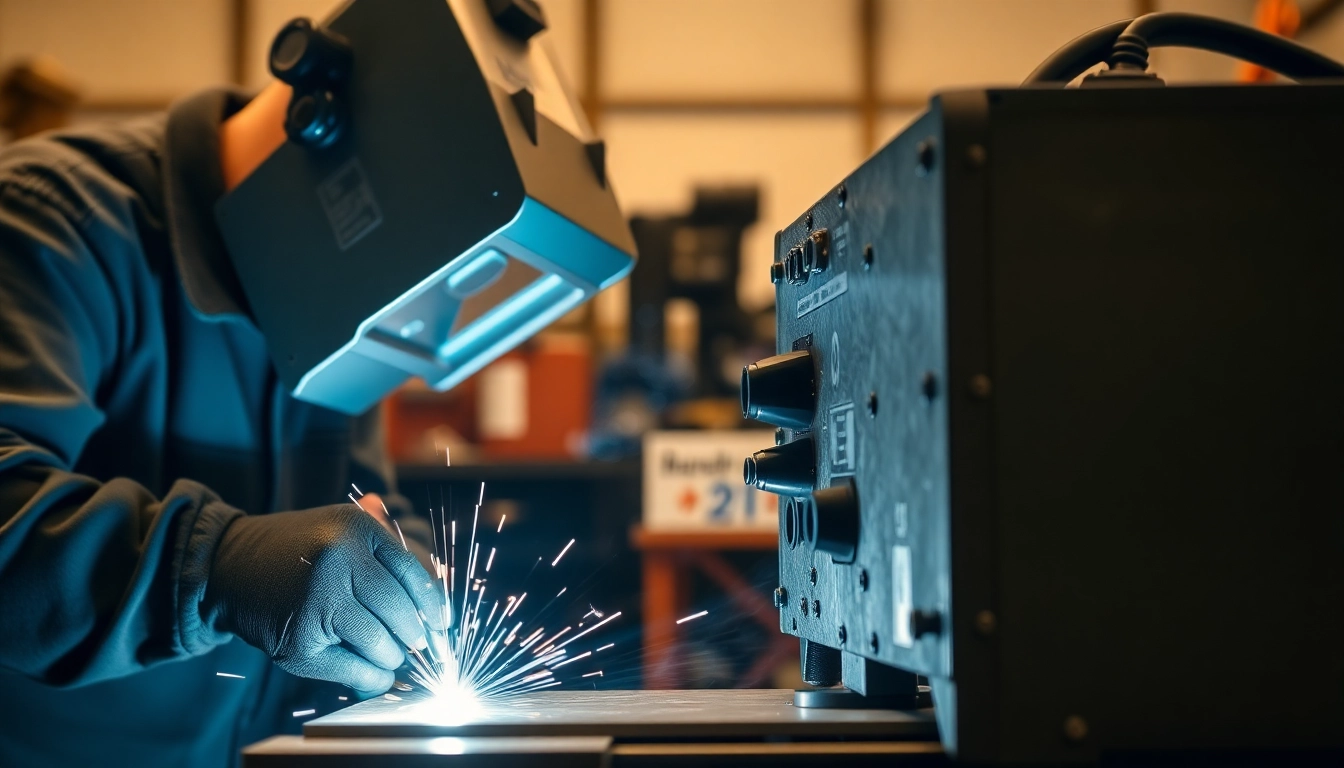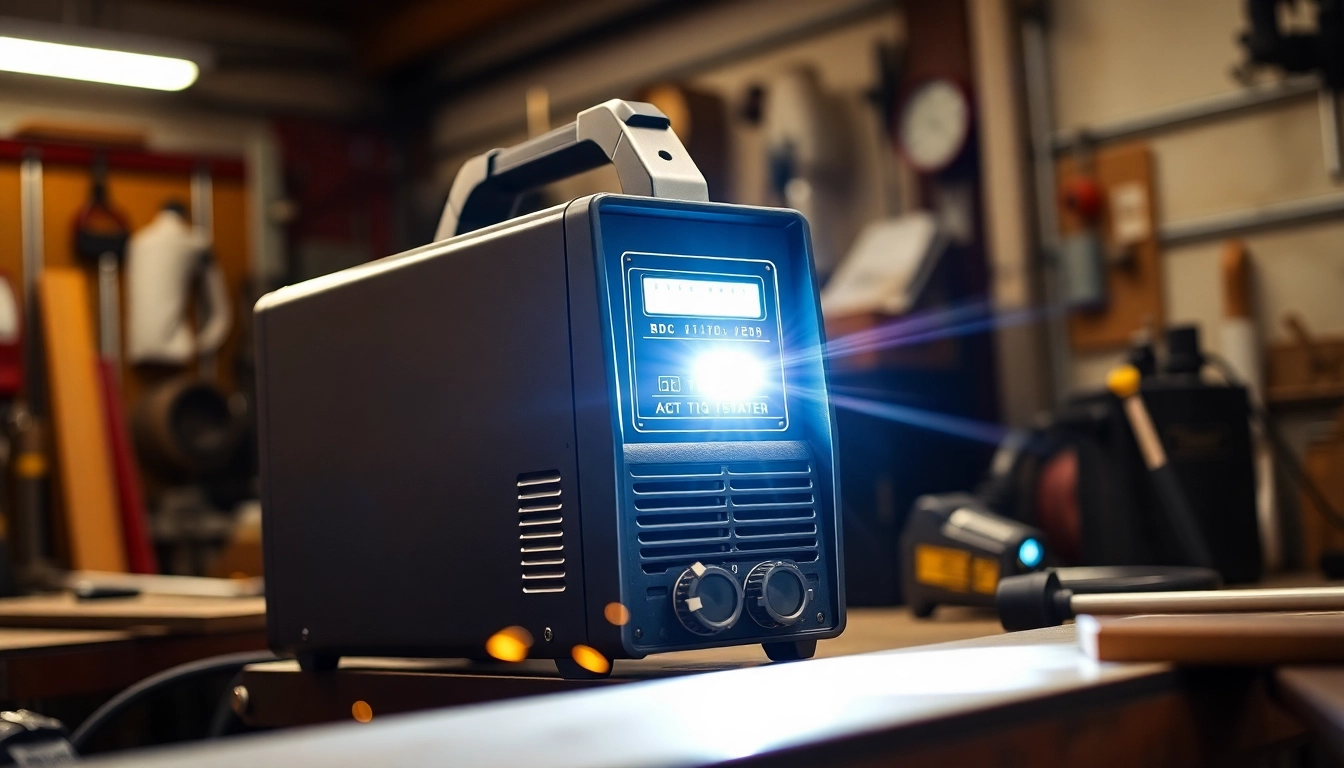Understanding AC DC TIG Welders
What is an AC DC TIG Welder?
An AC DC TIG welder is a versatile piece of equipment that combines both alternating current (AC) and direct current (DC) capabilities, allowing for a greater range of welding applications. Unlike conventional welders that may only operate on one current type, an AC DC TIG welder’s dual-function design makes it suitable for welding various materials such as aluminum, stainless steel, and mild steel. This versatility is particularly beneficial in professional and hobbyist settings, enabling welders to tackle a wide array of projects without needing multiple machines. This article aims to explore the intricacies of AC DC TIG welders, including their features, benefits, and best practices to ensure a successful welding experience.
Key Features of AC/DC Technology
The functionality of an AC DC TIG welder revolves around its unique capability to utilize both AC and DC settings. Here are some pivotal features that highlight the distinctions and advantages of using an AC DC welder:
- AC Functionality: This feature is essential for welding non-ferrous metals, notably aluminum. The alternating current produces a cleaning effect that removes oxidation and contamination from the surface of the material, resulting in a cleaner, stronger weld.
- DC Functionality: Suitable for ferrous metals, DC welding provides a stable and penetrating arc that facilitates deep weld penetration. It is especially advantageous for welding materials like stainless steel.
- Adjustable Balance Control: Many AC DC TIG welders come equipped with a balance control feature that allows users to adjust the ratio of cleaning to penetration, tailoring the welding process to the needs of the specific material.
- Pulse Welding Capability: Some models allow for pulse welding, which can reduce heat input and is particularly useful for thin materials, minimizing warping and control problems.
- Foot Pedal Control: Foot pedals enable users to adjust the current output without needing to stop their work, allowing for more precise control during the welding process.
Applications of AC DC TIG Welders
AC DC TIG welders are widely applicable in several industries due to their versatility and effectiveness. Some common applications include:
- Automotive Repair: Ideal for welding aluminum automotive parts, AC DC welders provide the required precision for critical components.
- Aerospace Manufacturing: The need for high-precision welds in aerospace applications makes AC DC TIG welders invaluable for creating components that can withstand rigorous specifications.
- Fabrication Shops: Used extensively in manufacturing metal structures and components, these welders can efficiently handle various materials and thicknesses.
- Artistic Metal Sculpting: Artists and sculptors leverage the control of AC DC TIG welders to fabricate intricate metal sculptures and designs.
Benefits of Using an AC DC TIG Welder
Precision and Control in Welding
One of the most significant advantages of AC DC TIG welders is their ability to produce high-quality welds with exceptional precision. This level of control is achieved through various features, including:
- Arc Stability: The cleaner and more stable arc produced by TIG welding ensures a higher quality of weld. This stability allows for better control when working on thin metals or intricate designs.
- Temperature Control: Users can adjust the temperature settings dynamically, which minimizes distortion and melting of surrounding areas, crucial for detailed work or thin materials.
- Clean and Hybrid Welds: With the ability to adjust AC and DC balances, welders can tailor their approach to achieve both cleaning and penetration, enhancing the overall quality of the weld.
Versatility Across Different Metals
The dual functionality of AC DC TIG welders allows for a wide spectrum of applications across various metals. This adaptability is a game-changer for both professional welders and enthusiasts, providing the capability to:
- Weld Aluminum: The AC function effectively removes oxides from aluminum, leading to strong and durable welds.
- Weld Stainless Steel: DC welding results in clean welds on stainless steel with minimal contamination, which is essential for structural integrity.
- Weld Mild Steel: The AC/DC capabilities ensure that even typical mild steel applications can be addressed effectively, providing flexibility in welding several different materials with one machine.
Cost-Effectiveness for Contractors
For contractors and welding professionals, the return on investment in an AC DC TIG welder is significant. Investing in one machine that handles multiple types of metals reduces the need for additional equipment. Here are reasons why they represent cost-effective solutions:
- Reduced Equipment Needs: Rather than purchasing separate machines for AC and DC welding, a single AC DC TIG welder can meet diverse project needs.
- Enhanced Repair Capability: Having versatile equipment can lead to offering broader service capabilities in repair shops, resulting in potential revenue increases.
- Lower Operational Costs: AC DC TIG welders typically have lower power consumption rates compared to alternative technologies, which can lead to reduced electricity bills over time.
Comparing Popular AC DC TIG Welder Models
Top Models in 2023 Overview
As of 2023, several models of AC DC TIG welders stand out due to their performance, features, and user feedback. Below is an overview of some top-rated options:
- Everlast PowerTIG 200DV: This model is well-regarded for its dual voltage feature, making it adaptable for various settings. It also offers a compact design without sacrificing performance.
- PrimeWeld 225X: Known for excellent performance and user-friendly settings, the PrimeWeld model supports both beginners and professionals effectively.
- Lincoln Electric Square Wave TIG 200: This machine is recognized for its high-frequency start, unmatched clean welding capabilities, and robust construction designed for heavy use.
Customer Reviews and Ratings
Customer feedback is invaluable when reviewing equipment, as it provides real-world insights into performance and reliability:
- Everlast PowerTIG: Users appreciate its wide range of features for the price, with many noting its suitability for aluminum welding.
- PrimeWeld 225X: Highlighted for its ease of use and reliability, users often emphasize its consistent performance and competitive pricing.
- Lincoln Electric Model: Lauded for durability and quality, this model appeals to professionals looking for equipment that withstands rigorous demands.
Price Comparison and Value Analysis
When selecting an AC DC TIG welder, understanding the price range and features available is crucial. Below is a generalized price comparison:
- Budget Models ($500-$1000): Models in this range often offer basic functionalities suitable for casual hobbyists or small workshops.
- Mid-Range Models ($1000-$2000): Enhanced features, including better durability, more control options, and added functionalities can be found here, catering well to part-time welders and small businesses.
- Professional Models ($2000+): These models typically come equipped with advanced technology, high-duty cycles, and exceptional build quality, targeting continuous-use applications in heavy industries.
Best Practices for TIG Welding
Preparation Before Welding
Sound preparation is the cornerstone of effective welding. It can greatly influence the quality of the weld produced. Follow these best practices:
- Material Cleaning: Ensure that all surfaces to be welded are clean and free from oil, grease, and moisture. Use appropriate cleaning solutions and methods suitable for the material type.
- Setup and Calibration: Adjust your welder settings according to the material’s thickness and type. Reference the manufacturer’s guidelines to establish optimal amperage and balance settings.
- Safety Checks: Before starting, conduct safety checks on equipment and workspaces. Ensure protective gear is worn, and ventilation is adequate to avoid inhaling fumes.
Techniques for Optimal Results
Utilizing proper welding techniques can enhance the quality of your work significantly. Consider the following:
- Steady Hand Technique: Maintaining a steady hand throughout the welding process is crucial for uniform weld beads and minimizing defects.
- Travel Speed: Adjusting travel speed relative to material thickness allows for optimal penetration and bead shape. Practice maintaining consistent speed to improve results.
- Correct Electrode Positioning: The angle and positioning of your electrode can affect the quality of the weld. Keeping a consistent angle and distance will yield better results.
Safety Tips While Using AC DC TIG Welders
Safety is paramount in welding operations. Follow these guidelines to ensure a safe working environment:
- Personal Protective Equipment (PPE): Always wear appropriate PPE, including welding gloves, helmets with suitable lenses, and protective clothing to shield from UV radiation and heat.
- Work Area Setup: Keep your workspace organized and clutter-free. Ensure proper ventilation and distance from flammable materials.
- Electrical Safety: Regularly inspect your welding machine for any electrical hazards. Proper grounding and using extension cords suited for the equipment are essential.
Conclusion and Recommendations
Choosing the Right Welder for Your Needs
Choosing the right AC DC TIG welder involves consideration of your specific needs, budget, and the materials you typically work with. Evaluate factors such as:
- Material Versatility: If your projects involve various metals, investing in a high-quality AC DC model is crucial.
- Frequency of Use: For those who weld frequently, prioritizing a welder with a higher duty cycle and advanced features may benefit long-term use.
- Future-Proofing: Consider potential future welding projects. Opting for a model that accommodates various applications can save you money and resources down the line.
Future Trends in TIG Welding Technology
The landscape of TIG welding continues to evolve, with emerging technologies enhancing capabilities and efficiency. Future trends may include:
- Smart Welding Technology: Integration of AI and machine learning to optimize welding parameters in real-time for enhanced welding quality.
- Advanced Pulse Features: Developments in pulse welding technologies to allow even greater control over heat input on various materials.
- Environmental Considerations: More focus on eco-friendly practices and machines designed to use less energy while maintaining performance.
Final Thoughts on AC DC TIG Welders
The versatility, precision, and cost-effectiveness of an ac dc tig welder make it an advantageous choice for anyone engaged in welding. Whether for professional use or casual projects, understanding its capabilities can elevate the quality of your work. By focusing on preparation, technique, and safety, you can leverage the benefits of these advanced machines to achieve superior welding outcomes.



